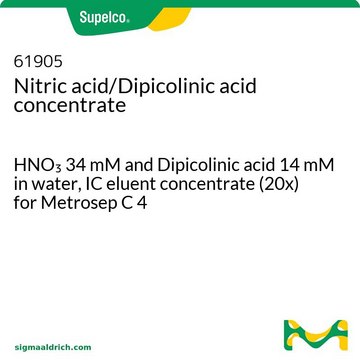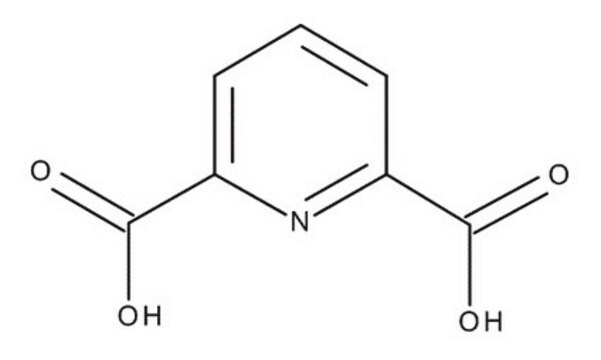Wszystkie zdjęcia(1)
Key Documents
50972
2,6-Pyridinedicarboxylic acid concentrate
0.02 M C7H5NO4 in water (0.04N), suitable for ion chromatography, eluent concentrate
Synonim(y):
2,6-Pyridinedicarboxylic acid solution, Dipicolinic acid solution
Zaloguj sięWyświetlanie cen organizacyjnych i kontraktowych
About This Item
Wzór empiryczny (zapis Hilla):
C7H5NO4
Numer CAS:
Masa cząsteczkowa:
167.12
Numer MDL:
Kod UNSPSC:
12000000
eCl@ss:
39151816
Identyfikator substancji w PubChem:
NACRES:
NB.21
Polecane produkty
opis
anionic
Poziom jakości
stężenie
0.02 M C7H5NO4 in water (0.04N)
metody
ion chromatography: suitable
ciąg SMILES
OC(=O)c1cccc(n1)C(O)=O
InChI
1S/C7H5NO4/c9-6(10)4-2-1-3-5(8-4)7(11)12/h1-3H,(H,9,10)(H,11,12)
Klucz InChI
WJJMNDUMQPNECX-UHFFFAOYSA-N
Opis ogólny
This eluent concentrate for ion chromatography is determined by potentiometric titration. Content and expiry date can be found on the certificate.
Zastosowanie
Powiązanie
Visit the IC Portal to learn more
Uwaga dotycząca przygotowania
Prepared with 2,6-pyridinecarboxylic acid and high purity water (18.2 MΩ, 0.2 μm filtered)
This page may contain text that has been machine translated.
produkt powiązany
Numer produktu
Opis
Cennik
Kod klasy składowania
10 - Combustible liquids
Klasa zagrożenia wodnego (WGK)
WGK 2
Temperatura zapłonu (°F)
Not applicable
Temperatura zapłonu (°C)
Not applicable
Środki ochrony indywidualnej
Eyeshields, Gloves
Wybierz jedną z najnowszych wersji:
Masz już ten produkt?
Dokumenty związane z niedawno zakupionymi produktami zostały zamieszczone w Bibliotece dokumentów.
Klienci oglądali również te produkty
Dongeun Yong et al.
Journal of clinical microbiology, 50(10), 3227-3232 (2012-07-28)
Accurate detection of metallo-β-lactamase (MBL)-producing Pseudomonas spp. and Acinetobacter spp. became very important with the increasing prevalence of carbapenem-nonsusceptible clinical isolates. The performance of phenotypic MBL detection methods may depend on the types of MBL and the characteristics of the
Kai Reineke et al.
International journal of food microbiology, 162(1), 55-63 (2013-01-29)
High pressure combined with elevated temperatures can produce low acid, commercially sterile and shelf-stable foods. Depending on the temperature and pressure levels applied, bacterial endospores pass through different pathways, which can lead to a pressure-induced germination or inactivation. Regardless of
Chaoliang Tan et al.
Chemical communications (Cambridge, England), 47(46), 12521-12523 (2011-10-27)
An effective single-walled carbon nanotube (SWNT) covalently loaded with unsaturated terbium emissive material was designed for specific and rapid (2-3 s) detection of calcium dipicolinate (CaDPA) (detection limit 1 μM). The nanoprobe was successfully assembled onto electrodes and its sensing
Development of metal-chelating inhibitors for the Class II fructose 1,6-bisphosphate (FBP) aldolase.
Geneviève Labbé et al.
Journal of inorganic biochemistry, 112, 49-58 (2012-05-02)
It has long been suggested that the essential and ubiquitous enzyme fructose 1,6-bisphosphate (FBP) aldolase could be a good drug target against bacteria and fungi, since lower organisms possess a metal-dependant (Class II) FBP aldolase, as opposed to higher organisms
P Zhang et al.
Journal of applied microbiology, 112(3), 526-536 (2012-01-04)
To analyse the dynamic germination of hundreds of individual superdormant (SD) Bacillus subtilis spores. Germination of hundreds of individual SD B. subtilis spores with various germinants and under different conditions was followed by multifocus Raman microspectroscopy and differential interference contrast
Nasz zespół naukowców ma doświadczenie we wszystkich obszarach badań, w tym w naukach przyrodniczych, materiałoznawstwie, syntezie chemicznej, chromatografii, analityce i wielu innych dziedzinach.
Skontaktuj się z zespołem ds. pomocy technicznej







